Chenguang Wang
Michael Pokorny
RepIt: Representing Isolated Targets to Steer Language Models
Sep 16, 2025Abstract:While activation steering in large language models (LLMs) is a growing area of research, methods can often incur broader effects than desired. This motivates isolation of purer concept vectors to enable targeted interventions and understand LLM behavior at a more granular level. We present RepIt, a simple and data-efficient framework for isolating concept-specific representations. Across five frontier LLMs, RepIt enables precise interventions: it selectively suppresses refusal on targeted concepts while preserving refusal elsewhere, producing models that answer WMD-related questions while still scoring as safe on standard benchmarks. We further show that the corrective signal localizes to just 100-200 neurons and that robust target representations can be extracted from as few as a dozen examples on a single A6000. This efficiency raises a dual concern: manipulations can be performed with modest compute and data to extend to underrepresented data-scarce topics while evading existing benchmarks. By disentangling refusal vectors with RepIt, this work demonstrates that targeted interventions can counteract overgeneralization, laying the foundation for more granular control of model behavior.
VisR-Bench: An Empirical Study on Visual Retrieval-Augmented Generation for Multilingual Long Document Understanding
Aug 10, 2025Abstract:Most organizational data in this world are stored as documents, and visual retrieval plays a crucial role in unlocking the collective intelligence from all these documents. However, existing benchmarks focus on English-only document retrieval or only consider multilingual question-answering on a single-page image. To bridge this gap, we introduce VisR-Bench, a multilingual benchmark designed for question-driven multimodal retrieval in long documents. Our benchmark comprises over 35K high-quality QA pairs across 1.2K documents, enabling fine-grained evaluation of multimodal retrieval. VisR-Bench spans sixteen languages with three question types (figures, text, and tables), offering diverse linguistic and question coverage. Unlike prior datasets, we include queries without explicit answers, preventing models from relying on superficial keyword matching. We evaluate various retrieval models, including text-based methods, multimodal encoders, and MLLMs, providing insights into their strengths and limitations. Our results show that while MLLMs significantly outperform text-based and multimodal encoder models, they still struggle with structured tables and low-resource languages, highlighting key challenges in multilingual visual retrieval.
EVA-MILP: Towards Standardized Evaluation of MILP Instance Generation
May 30, 2025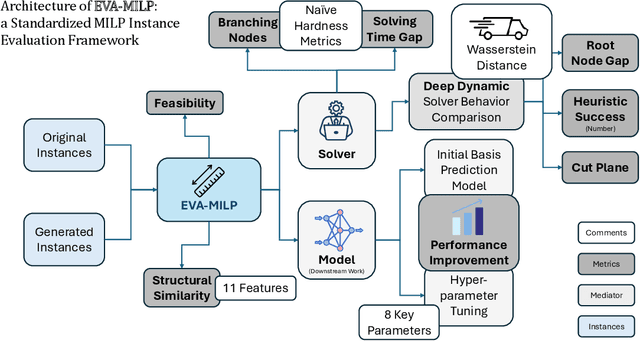
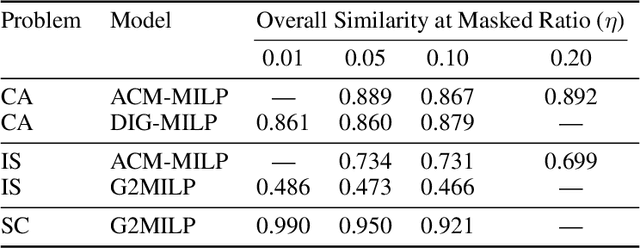
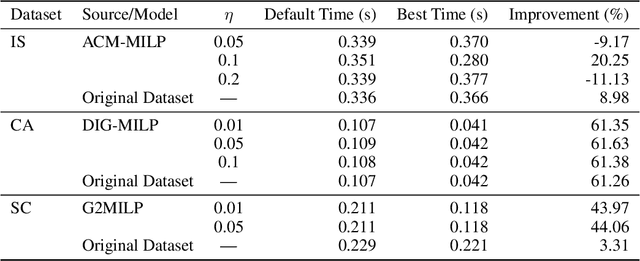
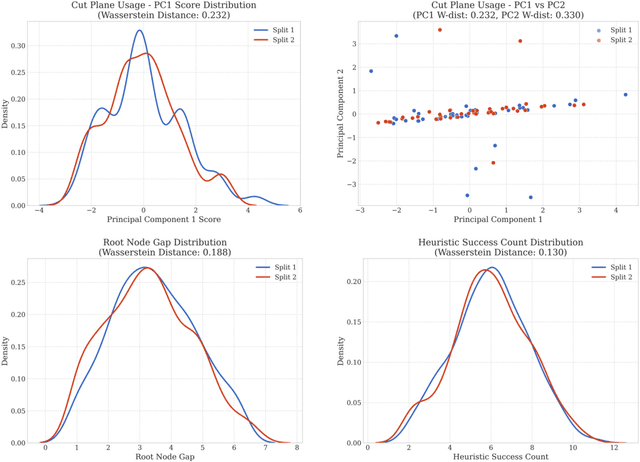
Abstract:Mixed-Integer Linear Programming (MILP) is fundamental to solving complex decision-making problems. The proliferation of MILP instance generation methods, driven by machine learning's demand for diverse optimization datasets and the limitations of static benchmarks, has significantly outpaced standardized evaluation techniques. Consequently, assessing the fidelity and utility of synthetic MILP instances remains a critical, multifaceted challenge. This paper introduces a comprehensive benchmark framework designed for the systematic and objective evaluation of MILP instance generation methods. Our framework provides a unified and extensible methodology, assessing instance quality across crucial dimensions: mathematical validity, structural similarity, computational hardness, and utility in downstream machine learning tasks. A key innovation is its in-depth analysis of solver-internal features -- particularly by comparing distributions of key solver outputs including root node gap, heuristic success rates, and cut plane usage -- leveraging the solver's dynamic solution behavior as an `expert assessment' to reveal nuanced computational resemblances. By offering a structured approach with clearly defined solver-independent and solver-dependent metrics, our benchmark aims to facilitate robust comparisons among diverse generation techniques, spur the development of higher-quality instance generators, and ultimately enhance the reliability of research reliant on synthetic MILP data. The framework's effectiveness in systematically comparing the fidelity of instance sets is demonstrated using contemporary generative models.
Importance Weighted Score Matching for Diffusion Samplers with Enhanced Mode Coverage
May 26, 2025Abstract:Training neural samplers directly from unnormalized densities without access to target distribution samples presents a significant challenge. A critical desideratum in these settings is achieving comprehensive mode coverage, ensuring the sampler captures the full diversity of the target distribution. However, prevailing methods often circumvent the lack of target data by optimizing reverse KL-based objectives. Such objectives inherently exhibit mode-seeking behavior, potentially leading to incomplete representation of the underlying distribution. While alternative approaches strive for better mode coverage, they typically rely on implicit mechanisms like heuristics or iterative refinement. In this work, we propose a principled approach for training diffusion-based samplers by directly targeting an objective analogous to the forward KL divergence, which is conceptually known to encourage mode coverage. We introduce \textit{Importance Weighted Score Matching}, a method that optimizes this desired mode-covering objective by re-weighting the score matching loss using tractable importance sampling estimates, thereby overcoming the absence of target distribution data. We also provide theoretical analysis of the bias and variance for our proposed Monte Carlo estimator and the practical loss function used in our method. Experiments on increasingly complex multi-modal distributions, including 2D Gaussian Mixture Models with up to 120 modes and challenging particle systems with inherent symmetries -- demonstrate that our approach consistently outperforms existing neural samplers across all distributional distance metrics, achieving state-of-the-art results on all benchmarks.
Where You Go is Who You Are: Behavioral Theory-Guided LLMs for Inverse Reinforcement Learning
May 22, 2025Abstract:Big trajectory data hold great promise for human mobility analysis, but their utility is often constrained by the absence of critical traveler attributes, particularly sociodemographic information. While prior studies have explored predicting such attributes from mobility patterns, they often overlooked underlying cognitive mechanisms and exhibited low predictive accuracy. This study introduces SILIC, short for Sociodemographic Inference with LLM-guided Inverse Reinforcement Learning (IRL) and Cognitive Chain Reasoning (CCR), a theoretically grounded framework that leverages LLMs to infer sociodemographic attributes from observed mobility patterns by capturing latent behavioral intentions and reasoning through psychological constructs. Particularly, our approach explicitly follows the Theory of Planned Behavior (TPB), a foundational behavioral framework in transportation research, to model individuals' latent cognitive processes underlying travel decision-making. The LLMs further provide heuristic guidance to improve IRL reward function initialization and update by addressing its ill-posedness and optimization challenges arising from the vast and unstructured reward space. Evaluated in the 2017 Puget Sound Regional Council Household Travel Survey, our method substantially outperforms state-of-the-art baselines and shows great promise for enriching big trajectory data to support more behaviorally grounded applications in transportation planning and beyond.
AgentXploit: End-to-End Redteaming of Black-Box AI Agents
May 09, 2025



Abstract:The strong planning and reasoning capabilities of Large Language Models (LLMs) have fostered the development of agent-based systems capable of leveraging external tools and interacting with increasingly complex environments. However, these powerful features also introduce a critical security risk: indirect prompt injection, a sophisticated attack vector that compromises the core of these agents, the LLM, by manipulating contextual information rather than direct user prompts. In this work, we propose a generic black-box fuzzing framework, AgentXploit, designed to automatically discover and exploit indirect prompt injection vulnerabilities across diverse LLM agents. Our approach starts by constructing a high-quality initial seed corpus, then employs a seed selection algorithm based on Monte Carlo Tree Search (MCTS) to iteratively refine inputs, thereby maximizing the likelihood of uncovering agent weaknesses. We evaluate AgentXploit on two public benchmarks, AgentDojo and VWA-adv, where it achieves 71% and 70% success rates against agents based on o3-mini and GPT-4o, respectively, nearly doubling the performance of baseline attacks. Moreover, AgentXploit exhibits strong transferability across unseen tasks and internal LLMs, as well as promising results against defenses. Beyond benchmark evaluations, we apply our attacks in real-world environments, successfully misleading agents to navigate to arbitrary URLs, including malicious sites.
From Perceptions to Decisions: Wildfire Evacuation Decision Prediction with Behavioral Theory-informed LLMs
Feb 24, 2025Abstract:Evacuation decision prediction is critical for efficient and effective wildfire response by helping emergency management anticipate traffic congestion and bottlenecks, allocate resources, and minimize negative impacts. Traditional statistical methods for evacuation decision prediction fail to capture the complex and diverse behavioral logic of different individuals. In this work, for the first time, we introduce FLARE, short for facilitating LLM for advanced reasoning on wildfire evacuation decision prediction, a Large Language Model (LLM)-based framework that integrates behavioral theories and models to streamline the Chain-of-Thought (CoT) reasoning and subsequently integrate with memory-based Reinforcement Learning (RL) module to provide accurate evacuation decision prediction and understanding. Our proposed method addresses the limitations of using existing LLMs for evacuation behavioral predictions, such as limited survey data, mismatching with behavioral theory, conflicting individual preferences, implicit and complex mental states, and intractable mental state-behavior mapping. Experiments on three post-wildfire survey datasets show an average of 20.47% performance improvement over traditional theory-informed behavioral models, with strong cross-event generalizability. Our complete code is publicly available at https://github.com/SusuXu-s-Lab/FLARE
Humanity's Last Exam
Jan 24, 2025Abstract:Benchmarks are important tools for tracking the rapid advancements in large language model (LLM) capabilities. However, benchmarks are not keeping pace in difficulty: LLMs now achieve over 90\% accuracy on popular benchmarks like MMLU, limiting informed measurement of state-of-the-art LLM capabilities. In response, we introduce Humanity's Last Exam (HLE), a multi-modal benchmark at the frontier of human knowledge, designed to be the final closed-ended academic benchmark of its kind with broad subject coverage. HLE consists of 3,000 questions across dozens of subjects, including mathematics, humanities, and the natural sciences. HLE is developed globally by subject-matter experts and consists of multiple-choice and short-answer questions suitable for automated grading. Each question has a known solution that is unambiguous and easily verifiable, but cannot be quickly answered via internet retrieval. State-of-the-art LLMs demonstrate low accuracy and calibration on HLE, highlighting a significant gap between current LLM capabilities and the expert human frontier on closed-ended academic questions. To inform research and policymaking upon a clear understanding of model capabilities, we publicly release HLE at https://lastexam.ai.
MLAN: Language-Based Instruction Tuning Improves Zero-Shot Generalization of Multimodal Large Language Models
Nov 19, 2024Abstract:We present a novel instruction tuning recipe to improve the zero-shot task generalization of multimodal large language models. In contrast to existing instruction tuning mechanisms that heavily rely on visual instructions, our approach focuses on language-based instruction tuning, offering a distinct and more training efficient path for multimodal instruction tuning. We evaluate the performance of the proposed approach on 9 unseen datasets across both language and vision modalities. Our results show that our language-only instruction tuning is able to significantly improve the performance of two pretrained multimodal models based on Llama 2 and Vicuna on those unseen datasets. Interestingly, the language instruction following ability also helps unlock the models to follow vision instructions without explicit training. Compared to the state of the art multimodal instruction tuning approaches that are mainly based on visual instructions, our language-based method not only achieves superior performance but also significantly enhances training efficiency. For instance, the language-only instruction tuning produces competitive average performance across the evaluated datasets (with even better performance on language datasets) with significant training efficiency improvements (on average 4x), thanks to the striking reduction in the need for vision data. With a small number of visual instructions, this emerging language instruction following ability transfers well to the unseen vision datasets, outperforming the state of the art with greater training efficiency.
Rethinking the "Heatmap + Monte Carlo Tree Search" Paradigm for Solving Large Scale TSP
Nov 14, 2024
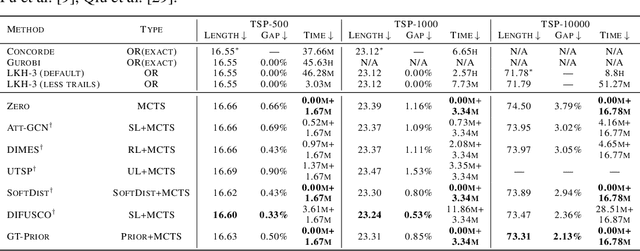
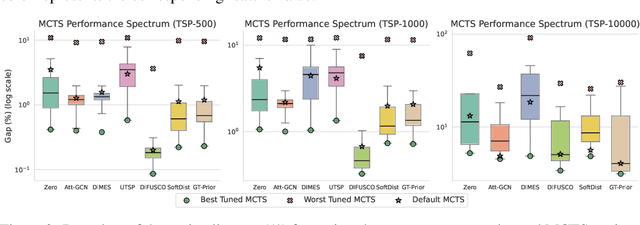
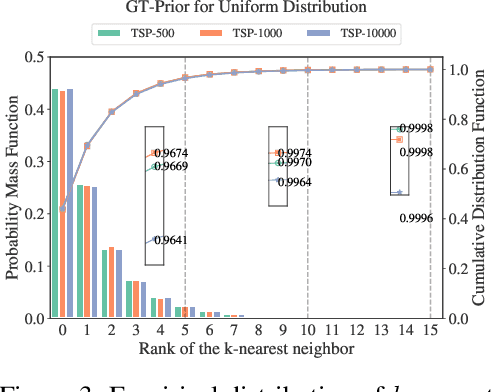
Abstract:The Travelling Salesman Problem (TSP) remains a fundamental challenge in combinatorial optimization, inspiring diverse algorithmic strategies. This paper revisits the "heatmap + Monte Carlo Tree Search (MCTS)" paradigm that has recently gained traction for learning-based TSP solutions. Within this framework, heatmaps encode the likelihood of edges forming part of the optimal tour, and MCTS refines this probabilistic guidance to discover optimal solutions. Contemporary approaches have predominantly emphasized the refinement of heatmap generation through sophisticated learning models, inadvertently sidelining the critical role of MCTS. Our extensive empirical analysis reveals two pivotal insights: 1) The configuration of MCTS strategies profoundly influences the solution quality, demanding meticulous tuning to leverage their full potential; 2) Our findings demonstrate that a rudimentary and parameter-free heatmap, derived from the intrinsic $k$-nearest nature of TSP, can rival or even surpass the performance of complicated heatmaps, with strong generalizability across various scales. Empirical evaluations across various TSP scales underscore the efficacy of our approach, achieving competitive results. These observations challenge the prevailing focus on heatmap sophistication, advocating a reevaluation of the paradigm to harness both components synergistically. Our code is available at: https://github.com/LOGO-CUHKSZ/rethink_mcts_tsp.
 Add to Chrome
Add to Chrome Add to Firefox
Add to Firefox Add to Edge
Add to Edge